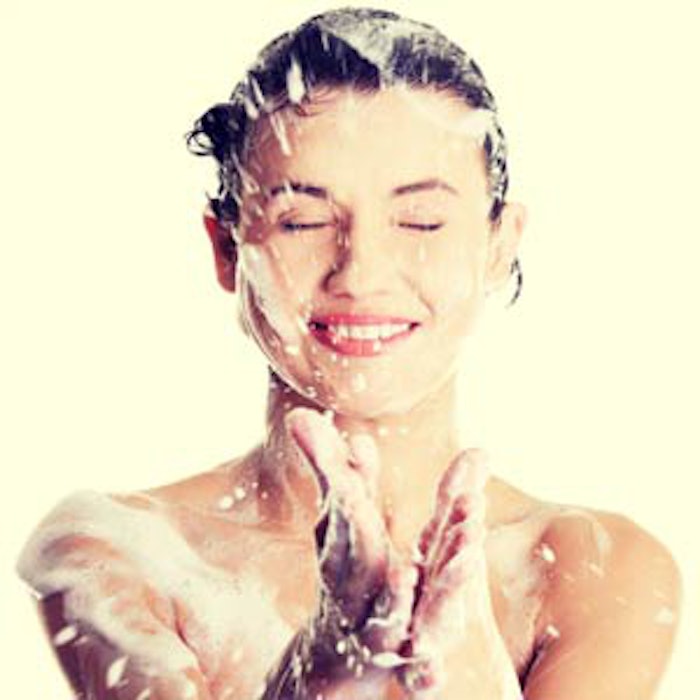
- Consumers’ criteria of cleansing products continue to evolve with added benefits.
- Achieving high-oil concepts is often a balancing act that requires the right chemistry to optimize loading levels and performance.
- Natural oils and/or emollients are often incorporated into body wash formulations to provide the desired moisturizing effect and a smooth skin feel after showering.
- The increasing use of natural oils to achieve skin and hair conditioning benefits can further fuel innovation.
For today’s fast-paced life styles, consumers demand that their hair and body care products be easy to use and time-saving. Furthermore, multi-sensory attributes offered from a product are becoming essential components to its overall success.
See also: Claims Inspired by Other Segments Propel Hair Care Growth
Consumers’ criteria of cleansing products continue to evolve with added benefits. For example, in body washes and shower gels, products that can deliver a luxurious skin feel in addition to cleaning are becoming the new standard. Not surprisingly, nearly 40% of all hand and body washes make moisturization and hydration claims, according to Mintel.
Likewise, there is an increasing demand for new experiences with hair care products, which are now driving innovation in this important personal care segment. The desires and wants of the consumers are finding their way to the shelves in new shampoos, conditioners and combination products.
The incorporation of high levels of oils is key to delivering desired attributes, which contribute to overall performance and consumer satisfaction. Increasingly, that means more natural oils are finding their ways in products.
Achieving these high-oil concepts, especially in cleansing products, is often a balancing act that requires the right chemistry to optimize loading levels and performance.
Moisturizing and Smoothing Body Washes
Natural oils and/or emollients are often incorporated into body wash formulations to provide the desired moisturizing effect and a smooth skin feel after showering. However, the presence of oils/emollients typically diminish the foaming power of a body wash formulation. The reduced foam quantity and quality often leads to a negative perception on the effectiveness of cleansing, leaving consumers questioning overall performance. It can be a daunting task for formulators to balance the need for foaming properties with the required amount of oils and/ or emollients needed for noticeable soft skin feel in a body wash formulation.
While standard sulfosuccinates are widely used as sulfate-free and/ or PEG-free surfactants in cleansing formulas, building a stable foam structure that can offer care properties and stand up under shower temperatures, especially in new high-oil cleansing formulas, poses a challenge. A new way to shape innovative texture, foam, and skin moisturization that builds efficacy into body washes and shampoos is accomplished with the use of diethylhexyl sodium sulfosuccinate (INCI name), or DSS.
This ingredient can assist formulators in designing personal care cleansers with new sensory appeal without compromising foaming performance or skin feel. For a typical surfactant system, the active surfactants are present at a level of 13%, although other levels of surfactants can be added while maintaining the integrity of the performance.
Even PEG- and sulfate-free formulations are possible with the use of the high-oil levels. Furthermore, combining typical anionic and amphoteric surfactants, DSS achieves stable multi-lamellar vesicles capable of incorporating 15–50% oil levels in a body wash formulation, while maintaining its foaming properties.
New Hair Care Functionality
The increasing use of natural oils to achieve skin and hair conditioning benefits can further fuel innovation with the high-oil concept. Incorporating high-oil levels of up to 50% with the use of DSS can add new sensorial effects in shampoo formulations.
It was once believed that combining a shampoo and conditioner into an all in one product was impossible. Many chemists were skeptical, but the 2-in-1 products appeared on the market and set a new watermark for consumer convenience. Now we are seeing an increasing trend toward using different natural oils in rinse-off and leave-in products for hair conditioning benefits.
Cleansing conditioners are an increasing market trend in most cultures around the world, as consumers want effective hair conditioning to be a normal part of their routine in maintaining attractive and healthy hair. The formulation concept described in this article is for high-oil body cleansing formulation systems that can be extended to shampoo applications. This can yield perceivable conditioning benefits due to the high-oil content in combination with conventional polymeric quaternary ammonium compounds.
Test Case: High-oil Shampoo-conditioning
The use of the new high-oil concept in a shampoo-conditioning test formulation was observed amongst non-trained consumers at home. Consumers were not permitted to use any conditioners or heating elements such as hair dryers, flat irons or curling irons, so the true performance of the formulated high-oil product could be isolated without complications from other treatments. Consumers were asked to describe and rate the performance during washing, after washing and the drying stage.
They also were asked to compare and rate the test product against the commercial shampoo or 2-in-1 products they often use with general scoring for the test product. With this information, insight can be achieved as to whether this high-oil concept in shampoo addresses consumer needs.
The benefits of the high-oil concept test shampoo allowed us to assess how well consumers perceived the tested product. The participating consumers had various hair types and scalp conditions which make the results more generalized.
During washing, the tested product was found to be easy to apply and offered good rinseability and smooth hair feel. Quick/ flash foam, foam quantity and creaminess of the foam were all adequate. After washing, the test product also provided good smoothness, easy combability and soft hair feel.
As for dry performance, most respondents reported their hair felt moisturized, volumized, smooth and soft, and easy to manage. In particular, participants with kinky, curly, and/or relaxed hair reported a greater benefit and satisfaction than participants with naturally straight or fine hair.
Overall, most of the consumers felt that the tested product performed well or even exceeded their expectations, with most preferring the test product over participant’s commercial product.
High-oil On the Rise
In conclusion, the high-oil concept looks poised to gain traction with support from ingredients such as DSS to address new consumer demands. No longer will formulators have to develop a body wash including high-oil levels that lacks the foaming capacity needed for high-performing washes.
The high-oil concept in hair care will also likely gain momentum as the demand for convenience continues. With multifunctional performance in demand, body washes are at the forefront in delivering what the consumers desire. Products with multifunctional benefits that help consumers move quickly through their daily routines will always be at the vanguard of style.
Racheal Young joined Evonik Personal Care in 2011 as a lab technician and is currently a chemist. Her specialty is to globally support the rinse-off group as it relates to hair care. Young attended Virginia Commonwealth University (VCU) where she earned a Bachelor of Science degree with a major in Biology and minors in Chemistry and Psychology. She also attended the VCU graduate program and earned a certificate in Business Administration.










